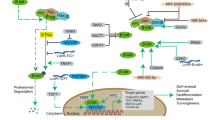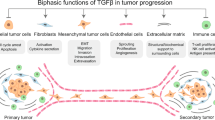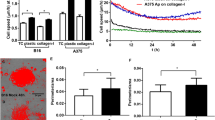Abstract
The growth and metastasis of solid tumors relies on the activities of polypeptide growth factors to recruit stromal tissue and expand the tumor mass. Pleiotrophin (PTN) is a secreted growth factor with angiogenic activity that has been found to contribute to the growth and metastasis of tumors including melanoma. Here, we present a gene therapy approach of targeting PTN in established tumors using ribozymes. Tetracycline-regulated ribozyme expression vectors were used to deplete conditionally PTN mRNA from melanoma xenograft tumors in vivo. We found that tetracycline-mediated initiation of ribozyme expression in established tumors reduced further tumor growth. Next, we generated synthetic anti-PTN ribozymes that inhibit PTN-dependent colony formation of cells in soft agar. Intraperitoneal administration of these synthetic ribozymes into nude mice inhibited growth of PTN-positive, subcutaneous melanoma. Furthermore, PTN released from the tumors into the circulation of mice was reduced after ribozyme treatment. These data show that ribozyme targeting of rate-limiting tumor growth factors could provide an efficient tool for cancer therapy and that the efficacy may be reflected in the reduction of the serum levels of the targeted protein, PTN.
This is a preview of subscription content, access via your institution
Access options
Subscribe to this journal
Receive 12 print issues and online access
$259.00 per year
only $21.58 per issue
Buy this article
- Purchase on Springer Link
- Instant access to full article PDF
Prices may be subject to local taxes which are calculated during checkout





Similar content being viewed by others
References
Liotta LA, Steeg PS, Stetler-Stevenson WG . Cancer metastasis and angiogenesis: an imbalance of positive and negative regulation. Cell 1991; 64: 327–336.
Li G et al. Function and regulation of melanoma–stromal fibroblast interactions: when seeds meet soil. Oncogene 2003; 22: 3162–3171.
Bogenrieder T, Herlyn M . Axis of evil: molecular mechanisms of cancer metastasis. Oncogene 2003; 22: 6524–6536.
Milner PG et al. A novel 17 kD heparin-binding growth factor (HBGF-8) in bovine uterus: purification and N-terminal amino acid sequence. Biochem Biophys Res Commun 1989; 165: 1096–1103.
Rauvala H . An 18-kd heparin-binding protein of developing brain that is distinct from fibroblast growth factors. EMBO J 1989; 8: 2933–2941.
Li YS et al. Cloning and expression of a developmentally regulated protein that induces mitogenic and neurite outgrowth activity. Science 1990; 250: 1690–1694.
Wellstein A et al. A heparin-binding growth factor secreted from breast cancer cells homologous to a developmentally regulated cytokine. J Biol Chem 1992; 267: 2582–2587.
Fang W et al. Pleiotrophin stimulates fibroblasts and endothelial and epithelial cells and is expressed in human cancer. J Biol Chem 1992; 267: 25889–25897.
Merenmies J, Rauvala H . Molecular cloning of the 18-kDa growth-associated protein of developing brain. J Biol Chem 1990; 265: 16721–16724.
Kovesdi I, Fairhurst JL, Kretschmer PJ, Böhlen P . Heparin-binding neurotrophic factor (HBNF) and MK, members of a new family of homologous, developmentally regulated proteins. Biochem Biophys Res Commun 1990; 172: 850–854.
Kuo MD, Oda Y, Huang JS, Huang SS . Amino acid sequence and characterization of a heparin-binding neurite-promoting factor (p18) from bovine brain. J Biol Chem 1990; 265: 18749–18752.
Bloch B, Normand E, Kovesdi I, Bohlen P . Expression of the HBNF (heparin-binding neurite-promoting factor) gene in the brain of fetal, neonatal and adult rat: an in situ hybridization study. Brain Res Dev Brain Res 1992; 70: 267–278.
Vanderwinden JM, Mailleux P, Schiffmann SN, Vanderhaeghen JJ . Cellular distribution of the new growth factor pleiotrophin (HB-GAM) mRNA in developing and adult rat tissues. Anat Embryol (Berl) 1992; 186: 387–406.
Wanaka A, Carroll SL, Milbrandt J . Developmentally regulated expression of pleiotrophin, a novel heparin binding growth factor, in the nervous system of the rat. Brain Res Dev Brain Res 1993; 72: 133–144.
Stoica GE et al. Identification of ALK (anaplastic lymphoma kinase) as a receptor for the growth factor pleiotrophin. J Biol Chem 2001; 276: 16772–16779.
Stoica GE et al. Midkine binds to anaplastic lymphoma kinase (ALK) and acts as a growth factor for different cell types. J Biol Chem 2002; 277: 35990–35998.
Powers C et al. Pleiotrophin signaling through anaplastic lymphoma kinase (ALK) is rate-limiting for glioblastoma growth. J Biol Chem 2002; 277: 14153–14158.
Bowden ET, Stoica GE, Wellstein A . Anti-apoptotic signaling of pleiotrophin through its receptor, anaplastic lymphoma kinase. J Biol Chem 2002; 277: 35862–35868.
Courty J et al. Mitogenic properties of a new endothelial cell growth factor related to pleiotrophin. Biochem Biophys Res Commun 1991; 180: 145–151.
Laaroubi K et al. Mitogenic and in vitro angiogenic activity of human recombinant heparin affin regulatory peptide. Growth Factors 1994; 10: 89–98.
Delbe J et al. Effect of heparin on bovine epithelial lens cell proliferation induced by heparin affin regulatory peptide. J Cell Physiol 1995; 164: 47–54.
Zhang N, Zhong R, Wang Z-Y, Deuel TF . Human breast cancer growth inhibited in vivo by a dominant negative pleiotrophin mutant. J Biol Chem 1997; 272: 16733–16736.
Chauhan AK, Li YS, Deuel TF . Pleiotrophin transforms NIH 3T3 cells and induces tumors in nude mice. Proc Natl Acad Sci USA 1993; 90: 679–682.
Czubayko F, Schulte AM, Berchem GJ, Wellstein A . Melanoma angiogenesis and metastasis modulated by ribozyme targeting of the secreted growth factor pleiotrophin. Proc Natl Acad Sci USA 1996; 93: 14753–14758.
Czubayko F, Riegel AT, Wellstein A . Ribozyme-targeting elucidates a direct role of pleiotrophin in tumor growth. J Biol Chem 1994; 269: 21358–21363.
Czubayko F et al. Molecular and pharmacologic targeting of angiogenesis factors – the example of pleiotrophin. Breast Cancer Res Treat 1995; 36: 157–168.
Wellstein A et al. Ribozyme targeting of angiogenic molecules. In: Teicher BA (ed). Antiangiogenic Agents in Cancer Therapy. Humana Press Inc.: Totowa, NJ, 1999, pp 423–441.
Schulte AM et al. Human trophoblast and choriocarcinoma expression of the growth factor pleiotrophin attributable to germ line insertion of an endogenous retrovirus. Proc Natl Acad Sci USA 1996; 93: 14759–14764.
Czubayko F et al. Adenovirus-mediated transduction of ribozymes abrogates Her-2/neu and pleiotrophin expression and inhibits tumor cell proliferation. Gene Therapy 1997; 4: 943–949.
Czubayko F, Schulte AM, Wellstein A . Ribozyme targeting of the growth factor pleiotrophin. In: Scanlon KJ (ed). Therapeutic Applications of Ribozymes. Humana Press: Totowa, NJ, 1998, pp 311–328.
Satyamoorthy K, Oka M, Herlyn M . An antisense strategy for inhibition of human melanoma growth targets the growth factor pleiotrophin. Pigment Cell Res 2000; 13 (Suppl 8): 87–93.
Gatz C, Frohberg C, Wendenburg R . Stringent repression and homogeneous de-repression by tetracycline of a modified CaMV 35S promoter in intact transgenic tobacco plants. Plant J 1992; 2: 397–404.
Gossen M, Bujard H . Tight control of gene expression in mammalian cells by tetracycline-responsive promoters. Proc Natl Acad Sci USA 1992; 89: 5547–5551.
Beigelman L et al. Chemical modification of hammerhead ribozymes. J Biol Chem 1995; 270: 25702–25708.
Liaudet-Coopman ED, Schulte AM, Cardillo M, Wellstein A . A tetracycline-responsive promoter system reveals the role of a secreted binding protein for FGFs during the early phase of tumor growth. Biochem Biophys Res Commun 1996; 229: 930–937.
Flory CM et al. Nuclease-resistant ribozymes decrease stromelysin mRNA levels in rabbit synovium following exogenous delivery to the knee joint. Proc Natl Acad Sci USA 1996; 93: 754–758.
Souttou B et al. Relationship between serum concentrations of the growth factor pleiotrophin and pleiotrophin-positive tumors. J Natl Cancer Inst 1998; 90: 1468–1473.
Symons RH . Small catalytic RNAs. Annu Rev Biochem 1992; 61: 641–671.
Pyle AM . Ribozymes: a distinct class of metalloenzymes [see comments]. Science 1993; 261: 709–714.
Taylor NR et al. Chimeric DNA–RNA hammerhead ribozymes have enhanced in vitro catalytic efficiency and increased stability in vivo. Nucleic Acids Res 1992; 20: 4559–4565.
Jaeger R et al. Serum levels of the angiogenic factor pleiotrophin in relation to disease stage in lung cancer patients. Br J Cancer 2002; 86: 858–863.
Scaringe SA, Francklyn C, Usman N . Chemical synthesis of biologically active oligoribonucleotides using beta-cyanoethyl protected ribonucleoside phosphoramidites. Nucleic Acids Res 1990; 18: 5433–5441.
De Wet JR et al. Firefly luciferase gene: astructure and expression in mammalian cells. Mol Cell Biol 1987; 7: 725–737.
Wellstein A et al. Autocrine growth stimulation by secreted Kaposi's fibroblast growth factor but not by endogenous basic fibroblast growth factor. Cell Growth Differ 1990; 1: 63–71.
McCall MJ, Hendry P, Jennings PA . Minimal sequence requirements for ribozyme activity. Proc Natl Acad Sci USA 1992; 89: 5710–5714.
Haseloff J, Gerlach WL . Simple RNA enzymes with new and highly specific endoribonuclease activities. Nature 1988; 334: 585–591.
Acknowledgements
We thank Dr SG Downing, A Murray and A Wüstenhagen for help with experiments. Drs A Aigner, HJ List (Georgetown University), P Pavco (RPI) and M Herlyn (Wistar Institute, Philadelphia) discussed the data and made helpful suggestions. Dr M Herlyn also kindly provided the 1205LU melanoma cell line and Dr M Vigny (INSERM, Paris, France) the 4B7 mouse monoclonal antibody. The studies were supported by grants from the NIH/National Cancer Institute to AW.
Author information
Authors and Affiliations
Rights and permissions
About this article
Cite this article
Malerczyk, C., Schulte, A., Czubayko, F. et al. Ribozyme targeting of the growth factor pleiotrophin in established tumors: a gene therapy approach. Gene Ther 12, 339–346 (2005). https://doi.org/10.1038/sj.gt.3302398
Received:
Accepted:
Published:
Issue Date:
DOI: https://doi.org/10.1038/sj.gt.3302398
Keywords
This article is cited by
-
Metastasis signatures: genes regulating tumor–microenvironment interactions predict metastatic behavior
Cancer and Metastasis Reviews (2008)
-
Pleiotrophin expression in astrocytic and oligodendroglial tumors and it’s correlation with histological diagnosis, microvascular density, cellular proliferation and overall survival
Journal of Neuro-Oncology (2007)



